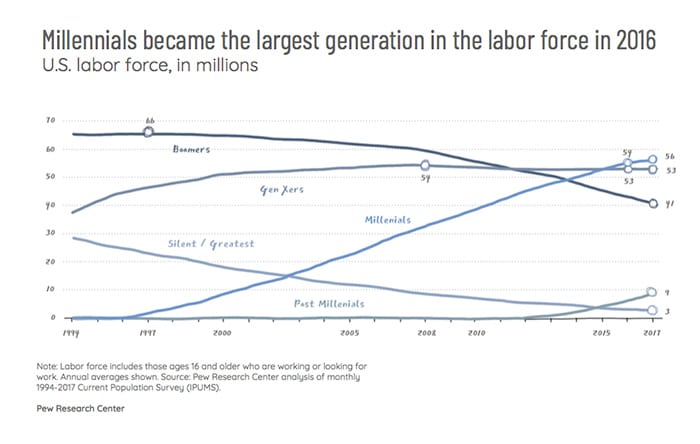The continuous evolution of technology has caused a widespread adoption of mobile learning in organizations, globally. In this article, we explore how providing employee training through mobile applications can become a boon for HR when it comes to increasing employee engagement and productivity.
Understanding Mobile Learning and Its Importance
More often than not, organizations struggle to craft employee training modules that are 100% engaging. One of the prime reasons for that is the dependence on the old-school-style of training, such as presentation-based classroom training and mentoring programs.
These conventional training methods, in spite of being well-designed and in-line with the organization’s goals, fail in maintaining the required employee interest, leading to poor productivity and eventually, lower gains. That’s when a strategy like mobile learning can help turn the tides in favor of the firm.
But what exactly is mobile learning?
Mobile learning is nothing but an ability that a firm offers its employees to learn through their preferred mobile devices in a way that best suits their learning style and convenience.
How It Can Become a Game Changer
While the conventional training methods increased the HR team’s workload, thanks to its manual recurring nature, mobile apps are making things easier. From simplifying the training module management to keeping track of employee progress and engagement, there are multiple benefits involved. Let’s dive in deeper to explore them.
1. More Efficient and Targeted Training
With the introduction of mobile learning, the HR department opens doors to an immersive learning experience for the employees. The long lessons can be broken up in shorter ones, keeping its concept as well as learner-centric.
The training modules can include a variety of formats, such as videos, infographics, bit-sized focused content, podcasts, and gamification (game-based learning), which the employees find interactive, easy-to-understand, and engaging at the same time. The combination of it generates a higher training completion rate, and in turn, overall organizational efficiency.
2. Increased Involvement
One of the best advantages of mobile learning is its availability on the go. Employees are able to access the training notes and other materials as and when they need it, both online as well as offline. So even when an employee is out for field-work or on a meeting and has some minutes to spare, these training modules are accessible on their handheld device.
Through such uninterrupted and automated learning access, the HR team successfully increases the employees’ involvement quotient in the organization.
3. Seamless Communication and Support
Gaps in communication and delayed support largely demoralize employees, making them disengaged from the company. This problem can be tackled through mobile learning wherein the employees can interact, seek or submit feedback and just-in-time job assistance, opening additional channels of communication among the workforce.
Trainers, on the other hand, can provide quick updates and push notifications, to connect to the learners in a more flexible way.
Such kind of immediate assistance instills the feeling of being a valued and integral part of the organization, boosting the employees’ engagement and efficiency to a great extent.
4. Improved Employee Management
With an increasing culture of work-from-home and remote workers, it is the HR team that has the toughest time in keeping the entire workforce on the same page.
While it’s easy to train the in-office staff, the remote workers often find themselves out of the loop. They are even made to visit the office regularly for training which negatively affects the whole nature of their working-style.
Mobile learning, however, eliminates this problem altogether as information is accessible regardless of employees’ geographical location. Employees feel connected and motivated while HRs attain a happier and more productive global flexible staff.
5. Insights & Reports
Is the training content provided to the employees engaging enough? Are the employees making actual progress? Is there room for improvement?
These are questions that often cloud the HR team’s mind, answers of which can be easily found through mobile learning.
Mobile learning can help analyze the engagement level of the content being provided through regular feedbacks, report analysis, as well as real-time insights. Then there is organized ongoing management of surveys, questionnaires and information insights. It helps determine the employees’ attitudes and progress levels.
A continuous assessment of this ensures there are zero loopholes and higher efficiency.
Other Advantages of Mobile Learning
- It aids the formal training
- It resonates well with the entire workforce, irrespective of the learners’ age group
- It reduces the forgetting curve
- It improves the planning capabilities of both the trainers and learners
- It results in a better and relaxed working environment
How It Can Benefit Employees
While HRs see mobile learning as a means to attain increased employee management and productivity, employees see it as a handy learning tool. Ultimately, HR Mobile Application makes the entire organization, more productive and efficient.

Mobile learning allows employees to learn at their own pace, at their convenient time, and in a manner that they find the most fitting. It gives them total control of what they are learning and how they wish to learn.
It provides learners with a personalized experience through focused content and regular trainer feedbacks, creating a greater learning curve.
As the training material is accessible 24/7, online and offline, employees can learn/explore/practice without devoting special time from their otherwise packed schedule. As a result, it becomes tremendously easy for them to multitask.
As employees learn by themselves through mobile learning, it makes them more self-reliant and confident in their abilities.
The quick updates and just-in-time support makes them feel wanted in the organization, leading them to perform even better.
Still Using Traditional Employee Training Methods?
If you are an entity still reliant on the conventional employee training, consider the U.S. Bureau of Labor Statistics. It highlights that the global workforce will comprise of 75% millennials by 2030.

That itself indicates the need to adapt to these newer training methods to fulfill the changing needs of the younger workforce. Confused about where to start? Get in touch with us and we’ll help you take the first step.
business group training – DepositPhotos


